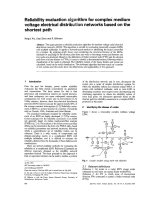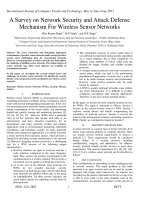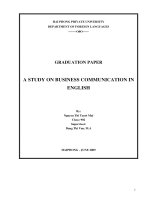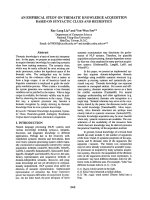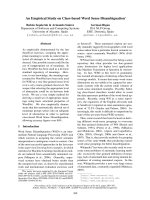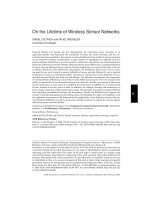Study on wireless communication networks based on different generati
Bạn đang xem bản rút gọn của tài liệu. Xem và tải ngay bản đầy đủ của tài liệu tại đây (276.81 KB, 6 trang )
See discussions, stats, and author profiles for this publication at: />
A Study On Wireless Communication Networks Based On Different
Generations
Article · May 2016
CITATIONS
READS
3
8,441
4 authors, including:
Shameek Mukhopadhyay
The Heritage Academy, Kolkata, India
9 PUBLICATIONS 5 CITATIONS
SEE PROFILE
Some of the authors of this publication are also working on these related projects:
Detection of Liver Disease using Machine Learning: Efficient Algorithm Selection View project
All content following this page was uploaded by Shameek Mukhopadhyay on 10 June 2016.
The user has requested enhancement of the downloaded file.
International Journal of Current Trends in Engineering & Research (IJCTER)
e-ISSN 2455–1392 Volume 2 Issue 5, May 2016 pp. 300 – 304
Scientific Journal Impact Factor : 3.468
A Study On Wireless Communication Networks Based On
Different Generations
Shameek Mukhopadhyay 1, Vatsal Agarwal 2, Sourav Sharma 3, Vineet Gupta 4
1
Assistant Professor BCA (H), The Heritage Academy, Kolkata
2,3,4
Student, BCA(H),The Heritage Academy, Kolkata
Abstract— The ability to communicate with people on move has evolved remarkably specially in
the domain of wireless technology. The mobile wireless evolved in a very short span of time. Mobile
Wireless technology has experienced different generations of technology starting from 0G. But the
mobile wireless communication was possible only by the introduction of 1G technology. In this
paper we study a gradual change in the wireless communication technology based on the different
generations starting from 0G to 1G, 2G, 3G, 4G, 5G and 6G.
Keywords— Mobile wireless communication, 0G, 1G, 2G, 3G, 4G, 5G, 6G, CDMA, OFDM,
MCCDMA, UWB, IPv6.
I.
INTRODUCTION
Wireless communication technology has evolved as one of the biggest contributions to mankind. The
wireless communications helps in transmission of information over a distance without any wires or
cables. This distance can be from a few meters to thousands of kilometers. Gradually, the mobile
phones came into play. The first mobile phone was introduced by Motorola in 1973. On 3 April
1973, Martin Cooper, a Motorola researcher and executive, made the first mobile telephone call
from handheld subscriber equipment, placing a call to Dr. Joel S. Engel of Bell Labs. Japan was the
first country to have a city wide cellular mobile network in 1979. After that the Nordic Mobile
Telephone (NMT) system launched in Denmark, Norway, Sweden and Finland in 1981. Then in mid
eighties First Generation (1G) mobile network was introduced which was fully automatic. The first
ever mobile phone to be approved by the FCC (Federal Communications Commission) in the USA
was the Motorola DynaTac in 1983. Gradually, mobile telephony developed in leaps and bounds
over the next decade, particularly with the arrival of handover technology.
II.
0G MOBILE TECHNOLOGY
The 0G mobile telecommunication also known as mobile radio telephone preceded modern
cellular mobile telephony technology. They were used for Analog system telecommunication. A
transmitter, receiver, control cable, antenna, phone unit and battery were used in this type of
technology for communication and they were used in vehicles. The device (telephone) would
connect to local telephone network only if it is in the range of 20 Kms. Each city had a central
antenna tower with 25 channels. This means that mobile transceiver should have a powerful
transmitter with a transmitting range of 50-70 Kms. Only few people were able to use this device as
only 25 channels were available. Roaming facility was not supported in this generation of analog
cellular Mobile Radio telephone system. Technologies used in 0G systems included PTT (Push to
Talk), MTS (Mobile Telephone System), IMTS (Improved Mobile Telephone Service),AMTS
(Advanced Mobile Telephone System), OLT (Norwegian for Offentlig Landmobil Telefoni, Public
Land Mobile Telephony) and MTD.
III.
FIRST GENERATION TECHNOLOGY (1G)
First generation or 1G refers to first generation of wireless networking which were used for
cellphones. It was introduced in 1980s. The first commercial automated cellular network was
@IJCTER-2016, All rights Reserved
300
International Journal of Current Trends in Engineering & Research (IJCTER)
Volume 02, Issue 05; May – 2016 [Online ISSN 2455–1392]
launched in Japan by Nippon Telephone and Telegraph (NTT) initially in the metropolitan area of
Tokyo. The 1G wireless networks used analog radio signals. Through 1G, a voice call gets
modulated to a higher frequency of about 150MHz and up as it is transmitted between radio towers.
This is done using a technique called Frequency-Division Multiple Access (FDMA). First generation
of wireless telecommunication technology also consist of various standards among which most
popular were Advance Mobile Phone Service (AMPS) used in USA, Nordic Mobile Telephone
(NMT) used in Denmark, Finland, Iceland, Norway and Sweden, Total Access Communication
System (TACS) used in UK, Radio Telefono Mobile Integrato (RTMI) used in Italy, Radiocom2000
used in France. All of the standards in 1G use frequency modulation techniques for voice signals and
all the handover decisions were taken at the Base Stations (BS). The spectrum within cell was
divided into number of channels and every call is allotted a dedicated pair of channels. Data
transmission between the wire part of connection and PSTN (Packet Switched Telephone Network)
was done using packet-switched network. 1G used to have low capacity and unreliable handoff with
poor voice links and there were no security issues, since anyone with an all-band radio receiver can
listen to the conversation.
IV.
SECOND GENERATION TECHNOLOGY (2G-2.75G)
2G is short for Second-generation wireless telephone technology. 2G cellular networks were
introduced in the late 1980s and they are based on digital transmission. It was first used in Finland. It
is based on the technology known as global system for mobile communication (GSM). In this
technology for the first time SIM (Subscriber Identity Module) is introduced and a more secured and
clear communication was established. Three main benefits of 2G networks over their predecessors
were that phone conversations were digitally encrypted, 2G systems were significantly more
efficient on the spectrum and 2G introduced data services for mobile, starting with SMS text
messages.
The 2.5G is the GPRS i.e. General Packet Radio Service which is an extension of 2G network that
have the capacity of launching packet based services.
The 2.75 G is the EDGE. GPRS networks evolved to Enhanced Data rates for GSM Evolution
(EDGE) networks with the introduction of 8PSK encoding. EDGE technology is an extended version
of GSM. It allows the clear and fast transmission of data and information. It is also termed as IMTSC or single carrier. EDGE technology was invented and introduced by Cingular, which is now
known as AT& T.
The primary differences between first and second generation cellular networks are:First generation systems are almost purely analog while the second generation systems are digital.
All second generation systems provide encryption to prevent eavesdropping.
2G technology allows error detection and correction and second generation systems allow channels
to be dynamically shared by a number of users.
Figure 1. 2G GSM architecture
@IJCTER-2016, All rights Reserved
301
International Journal of Current Trends in Engineering & Research (IJCTER)
Volume 02, Issue 05; May – 2016 [Online ISSN 2455–1392]
V.
THIRD GENERATION TECHNOLOGY (3G-3.75G)
The Third Generation (3G) will be digital mobile multimedia offering broadband mobile
communications with voice, video, graphics, audio and other information. 3G enhanced audio and
video streaming and has several times higher data speed. It supports video conferencing and gives
IPTV (TV through the Internet) support. 3G is based on CDMA technology. The features of 3G are
used in mobile applications, mobile store application, video streaming (YouTube) and GPS (Google
Maps, etc).
3G evolved into HSDPA (High-Speed Downlink Packet Access), HSPA, or 3.5G, which is up to five
times faster than 3G. The standard is a packet-based data service in W-CDMA downlink with data
transmission up to 8Mbps to 10Mbps over a 5MHz bandwidth in WCDMA downlink.
3.75G – HSUPA (High-Speed Uplink Packet Access) is a protocol which aims at providing higher
uplink speed equals to 5.8 Mbps. HSUPA is related to group of protocols from HSPA (High Speed
Packet Access) as defined by 3GPP (3rd Generation Partnership Project).HSUPA protocol name is
baptized by Nokia, however 3rd Generation Partnership Project(3GPP) calls it as Enhanced Uplink
(EUL).
VI.
FOURTH GENERATION TECHNOLOGY (4G)
4G is the short name for fourth-generation wireless that will replace 3G networks sometimes in
future. Providing broadband services would be one of the major goals of the 4G Wireless systems.
4G supports interactive multimedia, voice, streaming video, Internet and other broadband services. It
has high speed and capacity. This technology is a fully IP based mobile system. It has better spectral
efficiency and has interoperability with the existing wireless standards.
The frequency band of 4G is 2-8GHz and the bandwidth is 5-20 MHz. It supports upto 20Mbps or
more data rate. It supports packet switching. 4G systems are expected to provide real-time and
internet-like services.
Smart antennas for multiple-input and multiple-output (MIMO), IPv6 (Internet Protocol version 6),
VoIP (Voice Over Internet Protocol), OFDM (Orthogonal frequency-division multiplexing),
Software Defined Radio (SDR) system are some of the technologies used in 4G.
In our day to day life we take the help of 4G in mobile phones, in sensor of public vehicles and for
controlling traffic. 4G meets the demand for diverse users.
VII.
FIFTH GENERATION TECHNOLOGY (5G)
5G stands for fifth generation wireless systems. It is based on the IEEE 802.11ac standard. 5G will
provide better speeds and coverage than the current 4G. 5G increases network expandability up to
hundreds of thousands of connections. Wireless World Wide Web (WWWW), Dynamic Ad hoc
Wireless Network (DAWN) and Real Wireless World will be a reality with 5G. The aim of 5G is to
design a Multi-Bandwidth data path by integrating the current and future networks for new network
architecture of 5G real wireless world.
The 5G wireless internet networks are real wireless world which shall be supported by CDMA,
OFDM, MCCDMA (Multi-Carrier Code Division Multiple Access), UWB (Ultra wideband) and
IPv6. 5G technology has extraordinary data capabilities and has ability to tie together unrestricted
call volumes and infinite data broadcast within latest mobile operating system.
5G technology would offer high resolution for wireless gadget users and bi-direction large
bandwidth shaping. The superior quality services of 5G technology is based on policy to avoid error.
@IJCTER-2016, All rights Reserved
302
International Journal of Current Trends in Engineering & Research (IJCTER)
Volume 02, Issue 05; May – 2016 [Online ISSN 2455–1392]
Parameter
Network capacity
Peak data rate
Cell edge data rate
Latency
Suggested 5G Wireless Performance
Suggested Performance
10 000 times capacity of current network
10 Gbps
100 Mbps
< 1 ms
Table 1. Suggested 5G wireless performance
We now give a comparison of 1G to 5G technologies in a tabular form based on different parameters.
Technology
Bandwidth
Technology
1G
2kbps
Analog
cellular
2G/2.5G
14-64kbps
Digital cellular
Service
Mobile
telephony
Digital voice,
Short
messaging
Multiplexing FDMA
Switching
Circuit
Core
Network
Handoff
PSTN
TDMA/CDMA
Circuit/ circuit
for access
network and
air interface
PSTN
Horizontal Horizontal
3G
2mbps
Broadbandwidth/
CDMA/IP
Technology
Integrated high
quality audio,
video and data
4G
200mbps
Unified IP and
seamless combo of
LAN/WAN/WLAN
Dynamic
information access,
variable devices
CDMA
CDMA
Packet except for All packet
air interface
5G
>1gbps
4G+WWWW
Dynamic
information
access,
variable
devices with
AI
capabilities
CDMA
All packet
Packet network
Internet
Internet
Horizontal
Horizontal &
Vertical
Horizontal &
Vertical
Table 2. Comparison of different generation of technologies based on different parameters
@IJCTER-2016, All rights Reserved
303
International Journal of Current Trends in Engineering & Research (IJCTER)
Volume 02, Issue 05; May – 2016 [Online ISSN 2455–1392]
Figure 2. Functional architecture for 5G mobile networks
VIII.
SIXTH GENERATION TECHNOLOGY (6G)
6G mobile technology in upcoming name in field of mobile communication technologies, it is based
on set of standards which enable devices to connect internet with broadband wireless access. This
technology can come as 6G mobile technology, 6G technology, 6G mobile or 6G network as these
are rising and important technologies. 6G will implement a complete wireless network with no
limitation. It will have an incredible transmission speed in terabit range. It will maximize data
throughput and IOPS (Input Output Operations per Second).
REFERENCES
[1]
[2]
[3]
ITU World Radio communication Seminar highlights future communication technologies. International
Telecommunication Union.
Ajay K. Mishra, (2004), "Fundamentals of Cellular Network Planning and Optimization, 2G/2.5G/3G...Evolution Of
4G."John Wiley and Sons.
Tse, David; Viswanath, Pramod (2005).“Fundamentals of Wireless Communication” Cambridge University Press.
@IJCTER-2016, All rights Reserved
View publication stats
304
